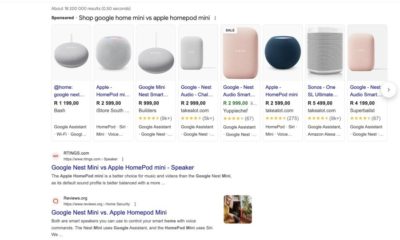Politics
The Intersection of Cybersecurity and IoT: Analyzing Attack Surface Impact
Published
10 months agoon
By
Drew Simpson
The proliferation of Internet of Things (IoT) devices has revolutionized the way we interact with technology. From smart homes to industrial automation, IoT has transformed various sectors, offering convenience, efficiency, and connectivity. However, this widespread adoption of IoT also brings forth significant cybersecurity challenges. In this article, we delve into the impact of attack surface on the intersection of cybersecurity and IoT, exploring the risks, vulnerabilities, and strategies to mitigate them.
Attack surface refers to the sum of all possible entry points and vulnerabilities that can be exploited by attackers. In the context of IoT, it encompasses the various endpoints, communication channels, protocols, and interfaces that IoT devices utilize. With the increasing number and diversity of IoT devices, the attack surface expands, creating more opportunities for cybercriminals to infiltrate networks and compromise sensitive information.
Risks and Vulnerabilities
The expanding attack surface in IoT devices amplifies the risks and vulnerabilities associated with their use. Poorly designed or outdated firmware, insecure communication protocols, weak authentication mechanisms, and insufficient security configurations all contribute to the vulnerability of IoT devices. These vulnerabilities can be exploited to gain unauthorized access, launch distributed denial-of-service (DDoS) attacks, intercept sensitive data, or manipulate connected systems.
Real-world examples highlight the impact of attack surface on IoT security. The Mirai botnet, for instance, compromised hundreds of thousands of IoT devices by exploiting their weak security configurations. These compromised devices were then used to launch large-scale DDoS attacks, causing widespread disruption. This incident underscores the importance of addressing the expanding attack surface in IoT devices to prevent such incidents in the future.
Implications for Cybersecurity
The increasing attack surface in IoT poses significant challenges for cybersecurity. Traditional security approaches that work well for conventional IT systems may not be sufficient for protecting IoT devices. The dynamic nature of IoT, with devices constantly connecting and disconnecting from networks, makes it difficult to maintain a consistent security posture. Additionally, the resource-constrained nature of many IoT devices limits their ability to implement robust security measures.
To effectively address attack surface impact, proactive cybersecurity measures are crucial. This includes regular patching and firmware updates, strong authentication and access controls, and encryption of data both at rest and in transit. Furthermore, implementing security frameworks and standards specific to IoT can help establish a baseline for security practices and ensure compliance across the ecosystem.
Strategies to Reduce Attack Surface
Minimizing the attack surface in IoT devices requires a multi-faceted approach. Secure design principles, such as the principle of least privilege, can help reduce the potential vulnerabilities in IoT devices. By only granting necessary privileges to users and components, the attack surface can be significantly limited. Secure coding practices, such as input validation and proper error handling, also play a critical role in reducing vulnerabilities.
Implementing network segmentation and access controls is another effective strategy to reduce the attack surface. By dividing the network into isolated segments, each with its own security controls, the potential impact of a compromised device can be contained, limiting lateral movement and reducing the overall attack surface. Similarly, robust monitoring and detection mechanisms can help identify and respond to potential security incidents promptly.
Defense in Depth Approach
A defense in depth strategy is crucial for mitigating attack surface impact in IoT environments. This approach involves layering multiple security controls throughout the IoT ecosystem, creating redundant layers of protection. By combining measures such as firewalls, intrusion detection systems, secure gateways, and encryption, organizations can strengthen their overall security posture and minimize the impact of an attack.
The continuous evolution of technology introduces new considerations in terms of attack surface impact. Technologies such as 5G and edge computing bring additional connectivity and processing capabilities to IoT devices. While
these advancements offer numerous benefits, they also expand the attack surface. With 5G enabling faster and more widespread connectivity, the number of IoT devices connected to networks increases, amplifying the potential vulnerabilities. Edge computing, on the other hand, distributes computing power closer to the devices, reducing latency and enhancing real-time processing. However, this decentralized architecture introduces additional entry points that need to be secured.
Artificial intelligence (AI) and machine learning (ML) in IoT also present unique attack surface considerations. AI and ML algorithms are increasingly utilized in IoT devices to analyze data, make autonomous decisions, and enhance functionality. However, if these algorithms are compromised, they can be manipulated to produce inaccurate results or malicious actions. Ensuring the integrity and security of AI/ML models is crucial to prevent attacks leveraging these technologies.
The Future of Cybersecurity and IoT
As IoT continues to evolve and expand, the intersection of cybersecurity and IoT will become increasingly critical. The future of cybersecurity in IoT lies in a proactive and holistic approach. Industry stakeholders, manufacturers, and policymakers must collaborate to establish robust security standards, promote secure design and coding practices, and foster a culture of continuous monitoring and response.
Moreover, addressing the attack surface impact requires ongoing research and innovation. Security solutions tailored specifically for IoT, including lightweight encryption algorithms, resource-efficient authentication mechanisms, and intrusion detection systems optimized for IoT environments, will play a pivotal role in protecting these devices.
The intersection of cybersecurity and IoT necessitates a comprehensive understanding of the impact of attack surface. As the attack surface expands with the growing number and diversity of IoT devices, the risks and vulnerabilities associated with them increase. However, through proactive cybersecurity measures, including secure design principles, network segmentation, and a defense in depth approach, organizations can mitigate these risks and minimize the attack surface.
The future of cybersecurity and IoT lies in a collaborative effort to establish industry-wide security standards, promote secure development practices, and leverage emerging technologies responsibly. By continuously addressing the impact of attack surface, we can ensure the security and integrity of IoT devices and harness their potential for innovation, connectivity, and efficiency while protecting against evolving cyber threats.
Jim Biniyaz
CEO and Co-Founder
Jim is CEO and Co-Founder of ResilientX Security and a General Partner in Parrot Media Group. He is passionate about Cyber Security, innovation, and product development. Previously Jim was Co-Founder of DeltaThreat and Next IQ Ltd.
You may like
-


How to Move from Cybersecurity Silos to Holistic Protection
-


The Intersection of SEO and IoT: The Role of SEO in Promoting IoT Devices
-


IoT Serving is Up Delicious Change: The Food Delivery Landscape
-


How LoRaWAN and Massive IoT are Reshaping Business and Society
-


Ethical Considerations in IoT Data Collection
-


The Role of Sensors in IoT Embedded System Design
Politics
Fintech Kennek raises $12.5M seed round to digitize lending
Published
7 months agoon
10/11/2023By
Drew Simpson
London-based fintech startup Kennek has raised $12.5 million in seed funding to expand its lending operating system.
According to an Oct. 10 tech.eu report, the round was led by HV Capital and included participation from Dutch Founders Fund, AlbionVC, FFVC, Plug & Play Ventures, and Syndicate One. Kennek offers software-as-a-service tools to help non-bank lenders streamline their operations using open banking, open finance, and payments.
The platform aims to automate time-consuming manual tasks and consolidate fragmented data to simplify lending. Xavier De Pauw, founder of Kennek said:
“Until kennek, lenders had to devote countless hours to menial operational tasks and deal with jumbled and hard-coded data – which makes every other part of lending a headache. As former lenders ourselves, we lived and breathed these frustrations, and built kennek to make them a thing of the past.”
The company said the latest funding round was oversubscribed and closed quickly despite the challenging fundraising environment. The new capital will be used to expand Kennek’s engineering team and strengthen its market position in the UK while exploring expansion into other European markets. Barbod Namini, Partner at lead investor HV Capital, commented on the investment:
“Kennek has developed an ambitious and genuinely unique proposition which we think can be the foundation of the entire alternative lending space. […] It is a complicated market and a solution that brings together all information and stakeholders onto a single platform is highly compelling for both lenders & the ecosystem as a whole.”
The fintech lending space has grown rapidly in recent years, but many lenders still rely on legacy systems and manual processes that limit efficiency and scalability. Kennek aims to leverage open banking and data integration to provide lenders with a more streamlined, automated lending experience.
The seed funding will allow the London-based startup to continue developing its platform and expanding its team to meet demand from non-bank lenders looking to digitize operations. Kennek’s focus on the UK and Europe also comes amid rising adoption of open banking and open finance in the regions.
Featured Image Credit: Photo from Kennek.io; Thank you!
Radek Zielinski
Radek Zielinski is an experienced technology and financial journalist with a passion for cybersecurity and futurology.
Politics
Fortune 500’s race for generative AI breakthroughs
Published
7 months agoon
10/11/2023By
Drew Simpson
As excitement around generative AI grows, Fortune 500 companies, including Goldman Sachs, are carefully examining the possible applications of this technology. A recent survey of U.S. executives indicated that 60% believe generative AI will substantially impact their businesses in the long term. However, they anticipate a one to two-year timeframe before implementing their initial solutions. This optimism stems from the potential of generative AI to revolutionize various aspects of businesses, from enhancing customer experiences to optimizing internal processes. In the short term, companies will likely focus on pilot projects and experimentation, gradually integrating generative AI into their operations as they witness its positive influence on efficiency and profitability.
Goldman Sachs’ Cautious Approach to Implementing Generative AI
In a recent interview, Goldman Sachs CIO Marco Argenti revealed that the firm has not yet implemented any generative AI use cases. Instead, the company focuses on experimentation and setting high standards before adopting the technology. Argenti recognized the desire for outcomes in areas like developer and operational efficiency but emphasized ensuring precision before putting experimental AI use cases into production.
According to Argenti, striking the right balance between driving innovation and maintaining accuracy is crucial for successfully integrating generative AI within the firm. Goldman Sachs intends to continue exploring this emerging technology’s potential benefits and applications while diligently assessing risks to ensure it meets the company’s stringent quality standards.
One possible application for Goldman Sachs is in software development, where the company has observed a 20-40% productivity increase during its trials. The goal is for 1,000 developers to utilize generative AI tools by year’s end. However, Argenti emphasized that a well-defined expectation of return on investment is necessary before fully integrating generative AI into production.
To achieve this, the company plans to implement a systematic and strategic approach to adopting generative AI, ensuring that it complements and enhances the skills of its developers. Additionally, Goldman Sachs intends to evaluate the long-term impact of generative AI on their software development processes and the overall quality of the applications being developed.
Goldman Sachs’ approach to AI implementation goes beyond merely executing models. The firm has created a platform encompassing technical, legal, and compliance assessments to filter out improper content and keep track of all interactions. This comprehensive system ensures seamless integration of artificial intelligence in operations while adhering to regulatory standards and maintaining client confidentiality. Moreover, the platform continuously improves and adapts its algorithms, allowing Goldman Sachs to stay at the forefront of technology and offer its clients the most efficient and secure services.
Featured Image Credit: Photo by Google DeepMind; Pexels; Thank you!
Deanna Ritchie
Managing Editor at ReadWrite
Deanna is the Managing Editor at ReadWrite. Previously she worked as the Editor in Chief for Startup Grind and has over 20+ years of experience in content management and content development.
Politics
UK seizes web3 opportunity simplifying crypto regulations
Published
7 months agoon
10/10/2023By
Drew Simpson
As Web3 companies increasingly consider leaving the United States due to regulatory ambiguity, the United Kingdom must simplify its cryptocurrency regulations to attract these businesses. The conservative think tank Policy Exchange recently released a report detailing ten suggestions for improving Web3 regulation in the country. Among the recommendations are reducing liability for token holders in decentralized autonomous organizations (DAOs) and encouraging the Financial Conduct Authority (FCA) to adopt alternative Know Your Customer (KYC) methodologies, such as digital identities and blockchain analytics tools. These suggestions aim to position the UK as a hub for Web3 innovation and attract blockchain-based businesses looking for a more conducive regulatory environment.
Streamlining Cryptocurrency Regulations for Innovation
To make it easier for emerging Web3 companies to navigate existing legal frameworks and contribute to the UK’s digital economy growth, the government must streamline cryptocurrency regulations and adopt forward-looking approaches. By making the regulatory landscape clear and straightforward, the UK can create an environment that fosters innovation, growth, and competitiveness in the global fintech industry.
The Policy Exchange report also recommends not weakening self-hosted wallets or treating proof-of-stake (PoS) services as financial services. This approach aims to protect the fundamental principles of decentralization and user autonomy while strongly emphasizing security and regulatory compliance. By doing so, the UK can nurture an environment that encourages innovation and the continued growth of blockchain technology.
Despite recent strict measures by UK authorities, such as His Majesty’s Treasury and the FCA, toward the digital assets sector, the proposed changes in the Policy Exchange report strive to make the UK a more attractive location for Web3 enterprises. By adopting these suggestions, the UK can demonstrate its commitment to fostering innovation in the rapidly evolving blockchain and cryptocurrency industries while ensuring a robust and transparent regulatory environment.
The ongoing uncertainty surrounding cryptocurrency regulations in various countries has prompted Web3 companies to explore alternative jurisdictions with more precise legal frameworks. As the United States grapples with regulatory ambiguity, the United Kingdom can position itself as a hub for Web3 innovation by simplifying and streamlining its cryptocurrency regulations.
Featured Image Credit: Photo by Jonathan Borba; Pexels; Thank you!
Deanna Ritchie
Managing Editor at ReadWrite
Deanna is the Managing Editor at ReadWrite. Previously she worked as the Editor in Chief for Startup Grind and has over 20+ years of experience in content management and content development.
